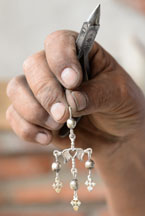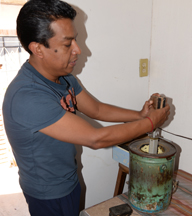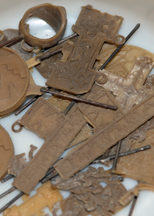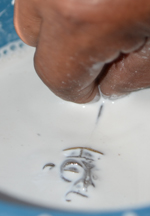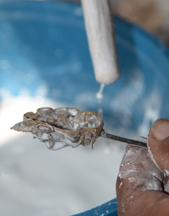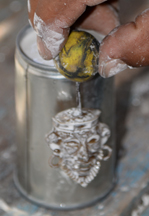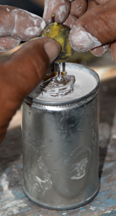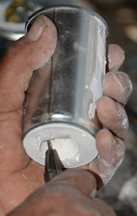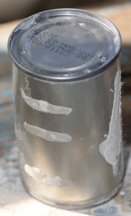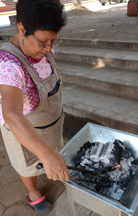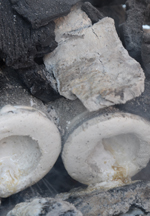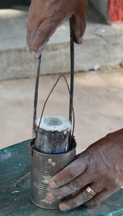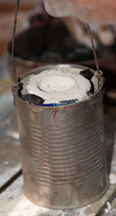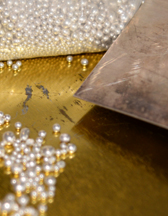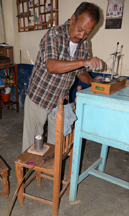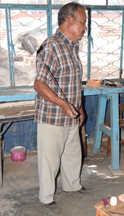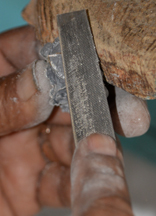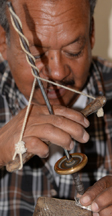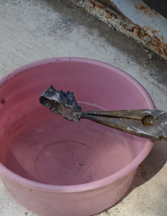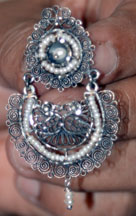
|
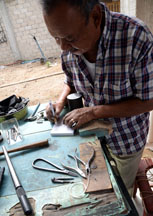
|

|
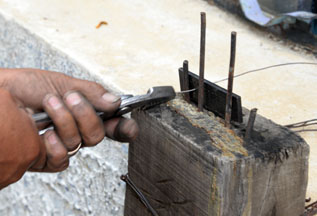
|
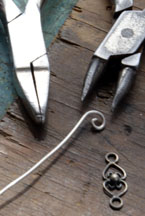
|
| One of Don Francisco's exquisite silver filigree earring. |
Don Francisco uses a pencil and paper to sketch original designs at his workbench. |
He prepares fine silver wire by repeatedly pulling it
through the successively smaller holes of a metal drawplate. |
Parts are shaped with pliers, then soldered together. |
How Elia and Don Francisco cast a pendant in a metal cope and drag mold:
 |
 |
 |
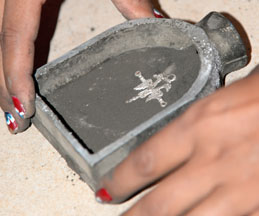 |
 |
| A dry mixture of cement and old engine oil fills the drag. |
Elia levels the mixture while
Soledad (her mother) supervises. |
A reusable metal pattern is then pushed into the powder. |
The cope is added. It will be filled with the cement mixture, tamped down and leveled. |
The cope and drag are then carefully separated. |
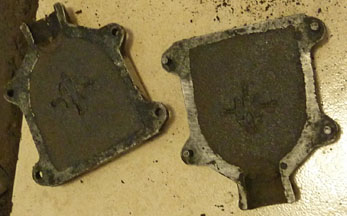 |
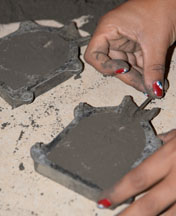 |
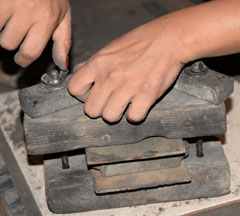 |
| The pattern is removed, leaving depressions in the compressed powder of both halves of the mold. |
The top is cut away to create a place for the molten metal to enter. |
The mold is put together between 2 sheets of metal, then clamped in a wooden vice. |
 |
 |
 |
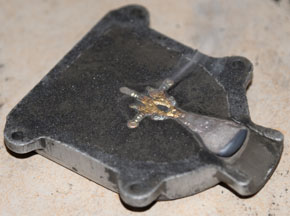 |
 |
| Francisco uses the flame from a foot-pumped kerosene torch to melt the silver,
then pours the molten silver from the clay crucible into the mold. |
The cast pendant in the open mold. |
The original pattern on the left and the casting. |
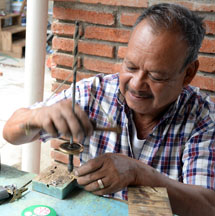 |
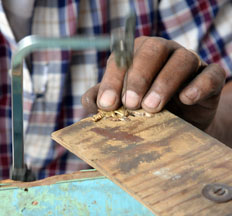 |
 |
| Francisco uses a traditional pump drill to make a hole. |
A coping saw and triangular needle file remove the excess metal. |
How Don Francisco solders a chased and repouseed heart ring:
 |
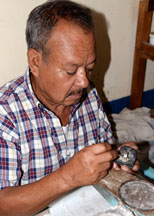 |
 |
| The components are temporarily wired together. |
The ring is placed on charcoal, flux is painted onto the joint with a turkey feather,
then pieces of silver solder (an alloy of silver and brass) are applied. |
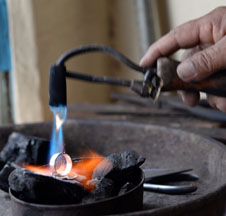 |
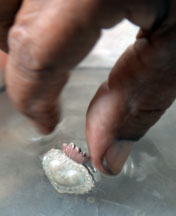 |
 |
| A torch melts the solder, the hot ring is quenched in pickle (a mild acidic solution) to remove oxidation,
then the ring is removed when cooled. |
The surface is further cleaned with a fine brass wire brush. |
 |
 |
 |
| The surface is burnished, then buffed with rouge to bring out the shine. |
The finished ring. |
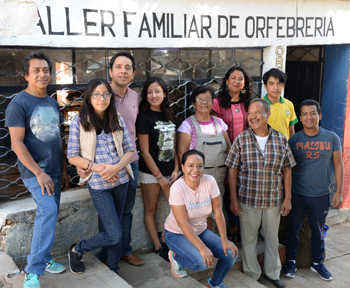
| For more information, please contact them (in Spanish) at:
Taller Familiar de Orfebreria
El Principe de Monte Alban
Plazuela Chapultepec
#106-A San Juan Chapultepec
Centro Oaxaca de Juárez
Oaxaca, México C.P. 68153
Soledad García 951-160-2109
Elia Gutiérrez 951-504-9320
You may email Elia at tonalliosogu@hotmail.com
Elia's Facebook page is DCO De Corazón Oaxaqueño |
Esta página en español
LINKS:
The Porras Ceramic Studio of Atzompa, Oaxaca, Mexico
Clay Filigree of the Velasco Villanueva Family of Atzompa, Oaxaca, Mexico
Mexican Ceramist, Capelo
Mexican Ceramist, Angelica Escarcega Rodriguez
Mexican Ceramist, José Luis Méndez Ortega
Mexican Ceramists, Guevara Ceramics
Mexican Ceramist, Tecpatl Ceramics
Pre-Columbian Maya Ceramic Reproductions
ARTCERA Wax Figures of Mexico
Tinsmithing in Guanajuato, Mexico
Backstrap Weaving School at Santa Maria del Rio, Mexico
Backstrap Woven Shawls of Esperanza Valencia Morra of Morelia
Foot-Loom Weaving in Central Mexico
Marquetry Boxes of José Antonio Rodríguez Salazar of Santa Maria del Rio, Mexico
Fernando Giron Pantoja, Woodcarver of Apaseo el Alto, Guanajuato, Mexico
Francisco Garcia Guevara, Jeweler in Guanajuato, Mexico
Ikat Shawls of Uriangato and Moroleon, Mexico
Gobelin Tapestry Weaving in Dolores Hidalgo, Mexico
Mexican Cane baskets
Margarita Orozco Ramirez of San Miguel de Allende Papermaker
Los Leñateros Papermaking, Printmaking, and Book Arts Studio of San Cristóbal de Las Casas, Mexico
Carmen Betancourt Icons of Celaya, Guanajuato, Mexico
Metal Casting in Cameroon
Filigree in Indonesia
Web page, photographs, and text by Carol Ventura in 2018.
Please look at Carol's home page to see more about crafts around the world.

